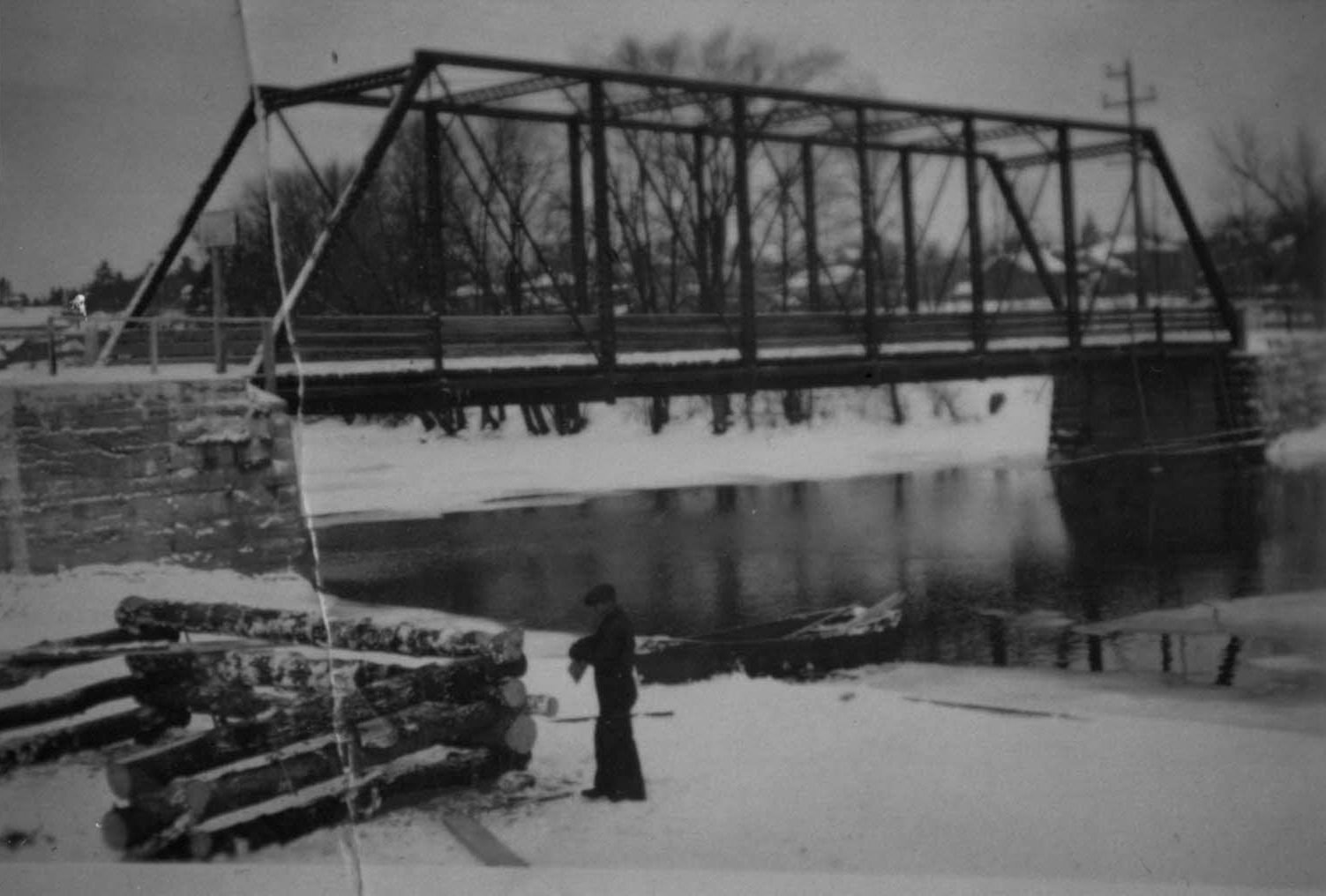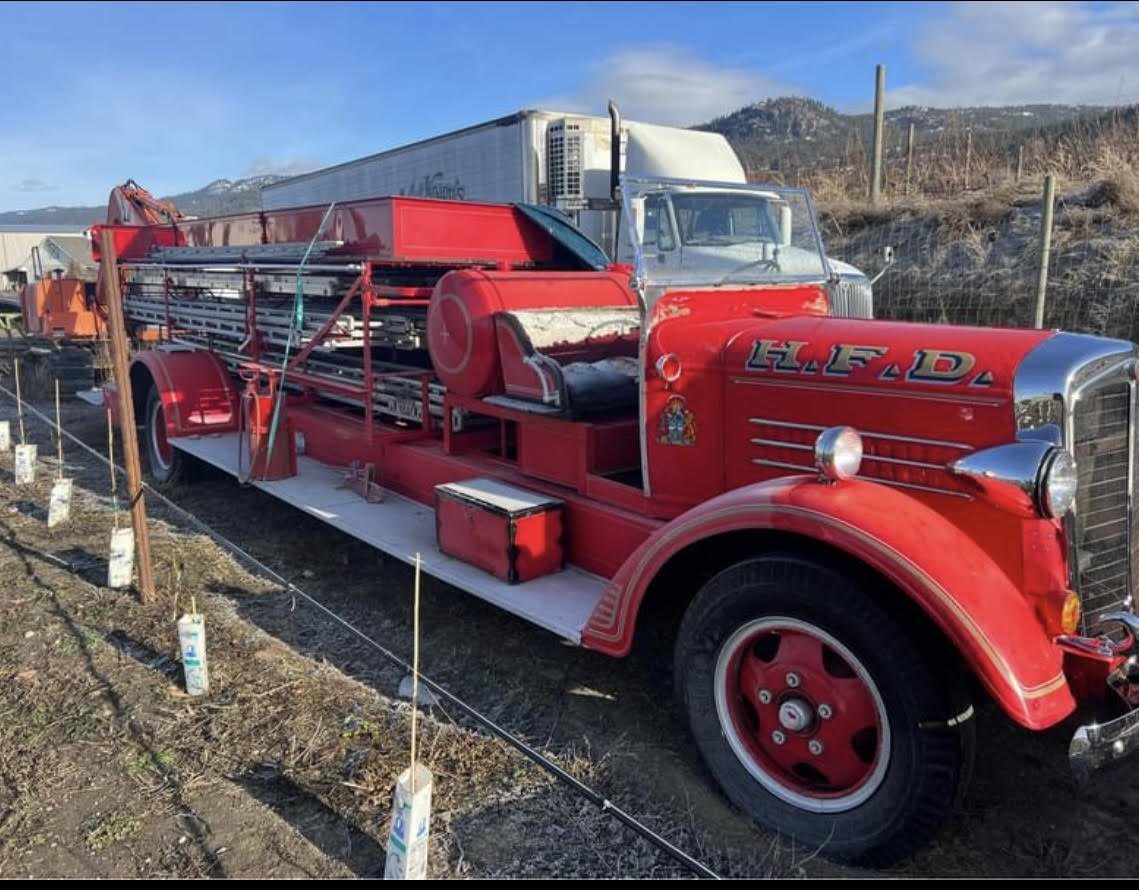Crowe River bridge, Ike Wright guarding entrance, looking eastc.1908. Ike lived in a shack near the bridge & guarding the entrance was his sole job.
Plan for the Marmora Iron Works in Upper Canada (property of Charles Hayes) 1828
THE MARMORA BRIDGES
The first bridge in Marmora was a wooden structure to the north of the dam, which landed on a flat rock on the north side of St. Matilda's church. From this map, acquired from the archives of Ontario, we can see the position of this bridge in relation to the ironworks and St. Matilda’s marked on the far left side. (For a key to the buildings thereon, click here) We can see, too, the original positions of the dams, north of where they are today.
Plan and Elevation of the New Bridge Constructed over the Crow River at the Marmora Iron Works 1828 - 358 feet -
Lucky for us, the map included a sketch of the bridge, noted as 358 feet long, with 5 cribs to take the weight of the six spans, remnants of which probably still lay below the water line. No doubt this bridge became a bother during the golden age of lumbering and gave reason for its removal.
The road from this bridge travelled on the west side of the church and followed south on what is now referred to as Hughes Lane. Today this area is now home of the Crowe Valley Conservation Authority, which is housed in a building originally built for Bethlehem Steel executives. At the time, of course, the rock cut, chiseled out in 1932, did not exist, so all traffic heading west to Norwood, Blairton or Crowe Lake was forced around the rock on "Old Norwood Road." There was, however, a footpath from St. Matilda's Church to Marble Point on Crowe Lake, which still exists today. The only remnant of that era is a part of the foundation of a cheese factory which exists just north of the present #7 Highway, on Hughes Lane. An old plaque stands deep in poison ivy and reads:
THE RIVERSIDE CHEESE FACTORY
The Riverside Cheese Factory was built on this site during the 1890's. Although only a two man operation, production was in excess of 800 pounds per day. Only cheddar cheese was made. The cheese factory was torn down when it became economically unfeasible to continue operations.
The second bridge over the Crowe River in Marmora was the iron bridge built in 1902.
This bridge was a suspension bridge, most likely built in the States and sent here as a kit, as many of them were, to be bolted together by local workers.
Mrs. William Sanderson with sons, Dougold and Magee c.1913
Sometime in 1934, as a make-work project during the depression, it was replaced with a cement bridge, and this one was dismantled and put in storage. With a push from Councillor Gordon Bennett, it was eventually resurrected and placed over the Gulf Stream (known known as the Gulf Bridge) linking Iron Bridge Road to Gulf Road, north of Marmora. In the nineties, it received new decking.
The Iron bridge, now over the gulf stream, with new decking in the 1990s
Bridge over Crowe River pre 1932
1919
c.1932 - The ramp to the temporary bridge before the dismantling of the iron bridge
The landing spot for the bridge at St. Matilda’s on the west side of the river.
Sign on the bridge over Crowe River. "Any person or persons riding or driving on or over this bridge at a faster rate than a walk, will on conviction thereof be subject to a fine as provided by law."
David Bridgman added: " Ah, the venerable open-web riveted iron strip box truss. Cheap and strong. That was the underlying structure for much of Canada for probably 50 years."
Marmora souvenir
The temporary bridge 1932, looking east with Cameron Street and the railway tracks at the end of the bridge.
A note from Jim Spry on Oct. 8, 2020:
Thank you for the information. It means so much to me living at 63 Cameron St. from 1958 to 1983. Mae Spry (Simmons) built her house (on Cameron St) in 1958 and the tracks were still until 1961. In the winter if we met Charlie Cronkright, one of us had to back up because after the road was ploughed, the train plow would push the snow back out onto the road, and Charlie had to get out to deliver the mail, Mom’s house was the 5th to be built on Cameron, built by Roy Solmes from Springbrook. Thank you again Always did wonder when the rock cut was first cut through.
circa 1932 - The temporary bridge is installed in preparation for the dismantling of the iron bridge, making way for the cement bridge in 1934
Notice path to temporary bridge to the right
REMEMBERING
Jennie Bedore-Hyland wrote: This was the equivalent of the public pool in my hometown of Marmora. During swimming lessons, we did "laps" by swimming in a big square from the dock to each of those piers, across to a certain rock, and then back to the dock.
Lauri Campbell : We used to ride our bikes from Deloro in the old road to the beach for swimming lessons
Dana Landry: Still cringe when I think about swimming those piers!
Katie McInroy Thorne Learned to swim about 100 feet south of the bridge. Was never allowed to jump from the bridge. My father did it and told us we were never allowed to ;)
Nettie King Jumped it many times... Swimming lessons to the piers and back.
Joan Deering I did both of those things and jumped off the dam too
Lynn Nesseth-Johnston I remember the snakes. They made us swim faster......
1934 THE CEMENT BRIDGE
The Cement Bridge was built in 1934. On March 8 of that year, The Marmora Herald reported"The busiest spot in this part of the county is the bridge over the Crowe River. Work is being rushed with the excavating and concrete footing for the pier on the east side which the work will be be completed on the west side."
The bridge was built with style, including iron railings and lamp posts. One of those lamps now rests at the Marmora Bed & Breakfast at 47 Forsyth Street, having been removed from the bridge when the Ministry of Transportation upgraded some time in the 1980's. In March of 2013, the provincial and federal government invested $3.9 million dollars in the bridge. The improvements included repairing and repaving the bridge deck, replacing the barrier wall and making various repairs to the concrete.










































